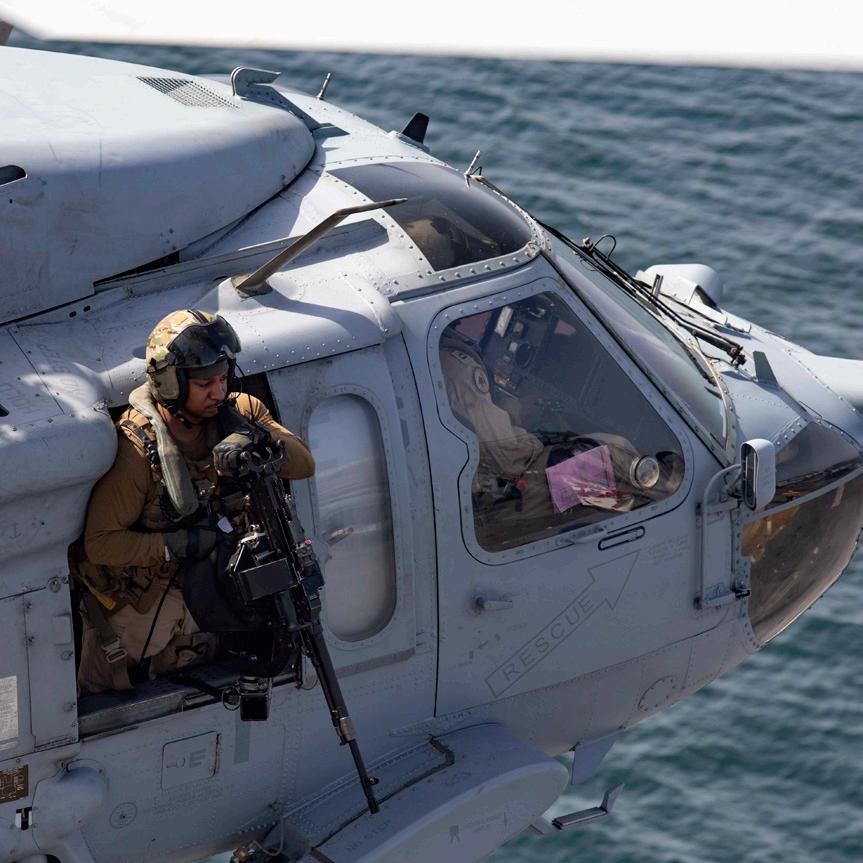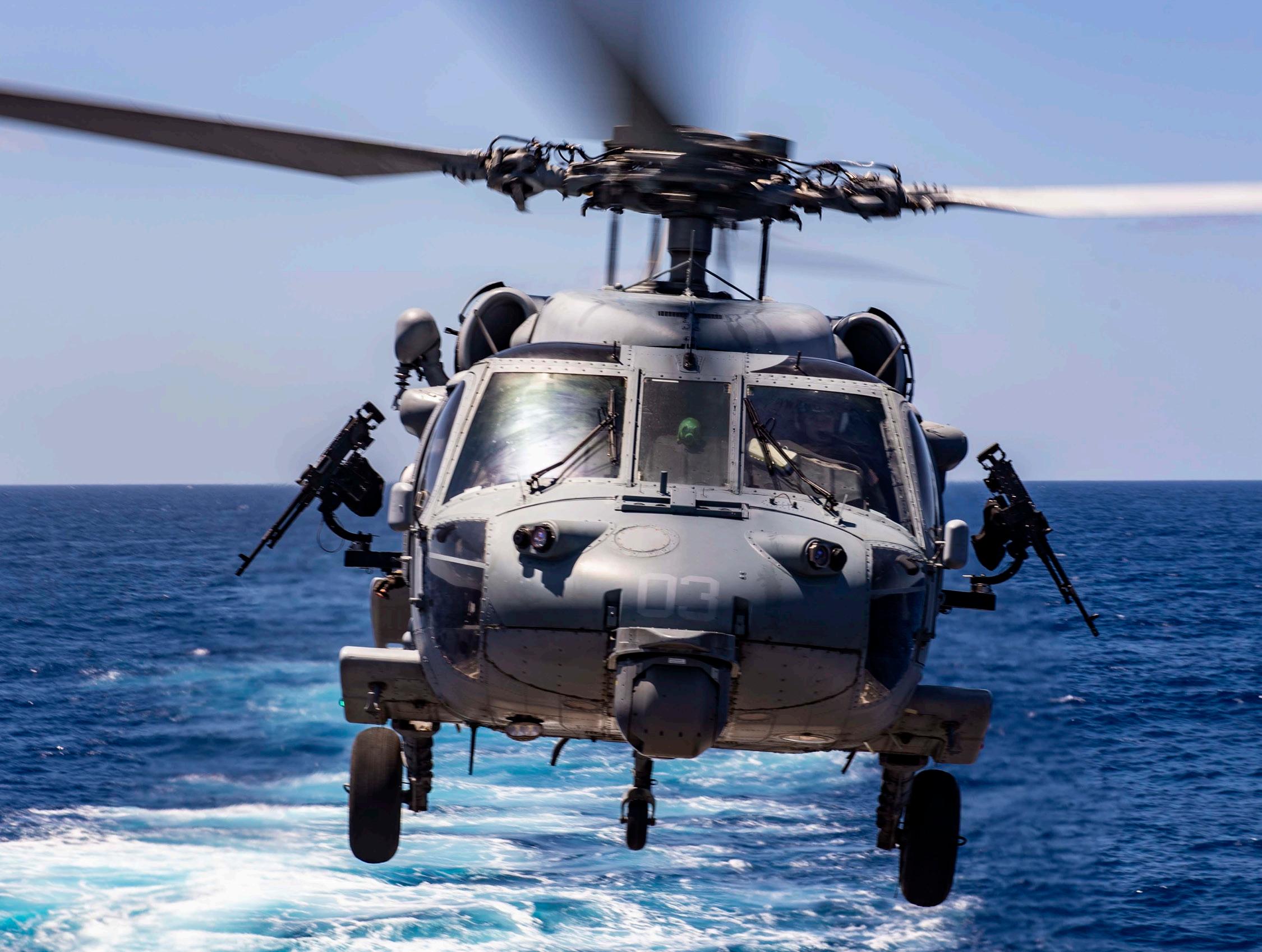
7 minute read
Safety is a Byproduct of Professionalism
The phrase “safety is a byproduct of professionalism” is one frequently heard around Red Ripper (Strike Fighter Squadron (VFA) 11) spaces. Through every single maintenance action and flight, Red Rippers professionally adhere to training, checklists and procedures, resulting in a safe, efficient and lethal combat-ready squadron.
Advertisement
Each quarter, the VFA-11 Safety Department organizes a squadron-wide safety standdown.
However, the Red Rippers have changed the setting from the all-hands auditorium to a much smaller, Chief-led work center setting. In this setting, we share lessons learned, address any concerns individuals might have, and give training on new maintenance practices for the Fleet. Since making the change to a smaller group setting, we have seen a significant increase in the interaction between Sailors and facilitators.
Conducting a squadron-wide safety standdown in an auditorium setting is ideal for sharing annual mandatory training efficiently. However, audiences in these settings generally stop retaining information at around the 30-minute mark. To understand the climate of the Sailors and uncover their concerns, Red Rippers found it necessary to provide a smaller and more comfortable environment where Sailors were more likely to speak up and participate. Adding to this, having their Chief lead the discussion allows the training to become more of a discussion, instead
By LT Frank Goldstein
...Professionalism...’ of regurgitating brief slides. To facilitate the quarterly standdowns, the squadron safety department conducts a meeting with senior enlisted leadership to discuss quarterly training goals, including mandatory topics, lessons learned from recent mishaps reports (MISRECS), and hazardous reports (HAZREPS), as well as specific feedback from Sailors. Having this discussion with the maintenance leadership also allows us to develop topics and talking points for the standdown. Following this meeting, safety department leadership generates discussion topics for each work center to begin discussions, and the Chiefs take it for action. One of the most effective components of this process is the ability to compile lessons learned. Division officers in attendance with their work centers are tasked to write a summary of the ideas, concerns and takeaways from the discussions. The safety department then compiles and writes a document for dissemination to squadron leadership to provide an idea on how we can improve our safety environment in the future. Since changing the safety standdown format, we have seen much greater participation and buy-in from members of the squadron. Officers and Sailors have a voice and the ability to speak up when they see an issue, no matter how small. Within this small group setting and professional atmosphere, safety becomes part of the routine, allowing the Red Rippers to focus on maintaining the highest levels of lethality and readiness on the flight deck. One of the most effective components of this process is the ability to compile lessons learned. U.S. Navy photo by Mass Communication Specialist 3rd Class Adelola Tinubu/Released
An OIR Medevac Becomes ‘Turn Back’

There were plenty of factors to consider for such a robust flight. The first decision involved the risk of stretching the wing’s standard operating procedure (SOP) for ship-to-shore and shore-to-ship limits. With such a long flight across the water and considering fuel burn rates, any ship-to-shore flight over 250 nautical miles (NM) was prohibited.
However, we knew we had other diverts available if needed. Additionally, adverse weather was forecast to begin moving in that might cause problems on the back end of the mission. Analyzing the hazards and in consultation with the squadron and air wing leadership, we determined that the benefits of rescuing a fellow flyer outweighed the risks. Less than one hour after notification, our crew, with the addition of our hospital corpsman and air wing flight surgeon, was off the deck for the 300 NM flight over open water. The beginning of the flight was benign as we split the Cyprus-Turkey corridor and established communications with Nicosia radar. Still feet wet and 50 miles from Incirlik Air Base (LTAG), but only 15 miles from the coast, we received a call on guard to contact a different Turkish controller. We complied, and the Turkish center controller responded with, “You do not have diplomatic approval, so you should turn back immediately.”
The helicopter aircraft commander (HAC), Lt. Cmdr. Wesley Johnson, passed our diplomatic clearance number; however, the air traffic controllers stated we did not have a flight plan on file and ordered our return to the ship. Although we passed them our filed flight plan information, we continued to hear, “turn back now.” The controls said, “Unable, we are at low fuel state, request to proceed directly to Lima Tango Alpha Golf.” After what seemed to be forever, we were
By LTJG Angela Stearn
authorized to continue directly to Incirlilk - or so we thought. Upon entering Turkish airspace, we noticed traffic off the 11 o’clock. We saw what we later visually identified as a Turkish F-16 intercepting us. We broke away from the coast and climbed for better reception to reach the Incirlik approach instead of the center. The aircrew gunners continuously gave updates on the jet’s position as it circled our helicopter. Still new to this environment, I could feel my heart rate increasing and a growing sense of tension coming from our crew in the back. The level-headedness and voice of reason that came from our HAC kept the team at ease and instilled confidence that we would safely complete our mission.
“Everything is fine. They are doing what we would do in this situation,” he said as if knowing all of our thoughts simultaneously. After a few laps and communicating with the Incirlik approach, the fighter jet returned to its home base. We landed safely at Incirlik Air Base minutes after sunset, and our medical team began examining the pilot. They took some time to evaluate the pilot’s condition and concluded that he suffered symptoms of decompression sickness (DCS), but was fit for helicopter transfer back to the aircraft carrier. We now prepared for the return trip, but with all the commotion of rescuing the patient, getting fuel, and saluting every senior member of the base, we failed to get an update on our weather before departing Incirlik.
As we headed south, there was lightning in the distance, so we contacted air traffic control to get an update on the weather, and asked for vectors to circumnavigate anything threatening. The controller assured us a southerly heading would bypass the storm.
ALERT!

REMAIN
That held for about ten minutes. Once we were over water, our reference to the horizon vanished, and the lightning became so frequent that our night vision goggles bloomed out, eliminating a vital situational awareness builder. Flying right seat, I instinctively shifted my scan to instruments and hawked the gauges to avoid vertigo as the turbulence jostled us around. Control continued to give us vectors in an attempt to keep us clear of the storm, but that proved futile as we started to encounter rain. We kept pressing through the storm with caution, turning west and hugging the coastline of Turkey, hoping to turn toward the carrier eventually.
Lt. Cmdr. Johnson took the controls and brought us around as one of our crewmen said, “Sir, I think that’s hail.” Acknowledging the immediate danger, we continued our turn away to avoid damage to the aircraft. Like any good Approach article, the swiss cheese started to line up and our radar altimeter failed,
Above: U.S. Navy photo by Mass Communication Specialist 2nd Class Anderson W. Branch/Released Left: U.S. Navy photo by Mass Communication Specialist 2nd Class Kaitlin Rowell
causing our altitude hold to switch to the alternate barometric altitude hold. Lt. Cmdr. Johnson flew us out of the hail as I worked to troubleshoot our equipment failure. Reinitializing the system accomplished nothing but frustration and resetting the circuit breaker was just as unsuccessful. At this point, we accepted the loss in capability and started to work through the decision of whether to keep pressing toward the ship or turn back toward Incirlik. We considered such factors as patient care, fuel state, weather, location of the carrier and aircraft degradations. Our HAC listened to the medical team’s assessment of the patient, and Lt. Cmdr. Johnson made the final decision.
We squawked “emergency,” and we were vectored for a safe return back to Incirlik. We decided to remain overnight and try again the next day, which yielded better weather and an uneventful return to the ship. The experience resulted in several valuable lessons learned. First, remain mentally alert for every flight. A routine flight can turn dynamic in a matter of seconds. The crew woke up that morning, planning for the usual plane guard flight and ended up flying a long-distance medevac mission.
Second, check the weather. Had we taken the extra 10 minutes to get a clear image of the forecasted weather, we may have entirely avoided putting ourselves into an uncomfortable situation.
Finally, as a leader, the aura you project in a high-stress situation matters. Lt. Cmdr. Johnson’s calmness and confidence kept the entire crew composed during an air intercept, thunderstorm and aircraft emergency.
I hope you, too, take away a few lessons learned from our mistakes, strive for excellence and always be ready to execute the mission.





